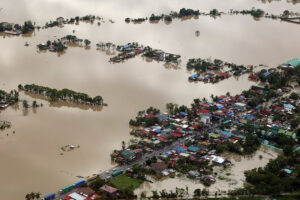Typhoons could slow PHL growth — IMF

THE PHILIPPINE ECONOMY could face stronger inflationary pressures and slower growth as increasingly frequent and severe typhoons disrupt supply chains and farm production, the International Monetary Fund (IMF) said.
“The Philippines is highly exposed to natural hazards, particularly typhoons, which are the most frequent and costliest climate shocks in the country,” the IMF Regional Office for Asia and the Pacific said in a Facebook post. “These events represent supply shocks, creating inflationary pressure and reducing economic activity.”
The IMF estimated that a Category 5 storm could raise headline inflation by 0.4 percentage point (ppt) and food inflation by 0.7 ppt, based on regional data from its latest Article IV consultation with Manila.
Super Typhoon Ragasa, locally named Nando, was one such storm that battered the country late last month, causing floods and an initial P1.38 billion in agricultural damage.
Data from the Department of Agriculture showed that the southwest monsoon and typhoons Mirasol, Nando and Opong have caused P7.71 billion in combined losses. Farmers and fisherfolk lost 472,701 metric tons in production and 205,016 hectares of farmland.
The IMF said such weather shocks could drag agricultural labor productivity by as much as 2.5% and shave 0.4 ppt off economic growth, with estimated damage amounting to about 0.2% to 0.3% of gross domestic product (GDP).
Inflation accelerated to 1.7% in September from 1.5% in August, the fastest in six months, the Philippine Statistics Authority said. While slower than 1.9% a year earlier, the pickup reflected higher food prices after recent typhoons.
The agency said vegetable prices rose 19.4% in September, up from 10% in August — the steepest increase since January. Food inflation climbed to 0.8% from 0.6% in the previous month.
Average inflation this year stands at 1.7%, matching the Bangko Sentral ng Pilipinas’ (BSP) full-year target but slightly above the IMF’s 1.6% forecast.
The economy expanded by 5.4% in the first half, slower than last year’s 6.2% but in line with the IMF’s full-year outlook.
Economy Secretary Arsenio M. Balisacan said growth might soften further in the third quarter due to typhoon-related disruptions but could still meet the lower end of the government’s 5.5% to 6.5% goal. The third-quarter GDP data will be released on Nov. 7.
The IMF said monetary authorities should carefully balance inflation control with the need to support growth after natural disasters. “Post-disaster, monetary policy must carefully weigh trade-offs between anchoring inflation expectations and supporting economic recovery,” it said.
The BSP delivered its fourth straight 25-basis-point (bp) rate cut on Oct. 9, bringing its benchmark rate to a three-year low of 4.75%. It has reduced borrowing costs by 175 bps since August 2024.
“Fiscal policy is central to building climate resilience before disasters strike, to help mitigate the macro impacts of natural disasters,” the IMF added. — Katherine K. Chan











